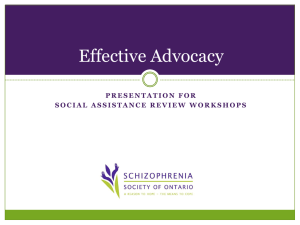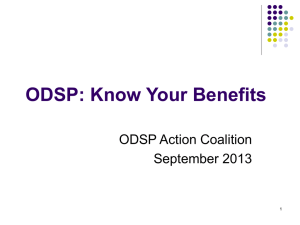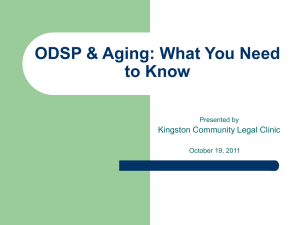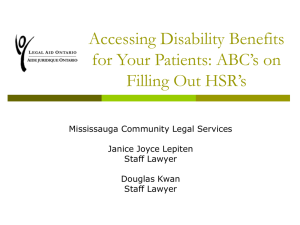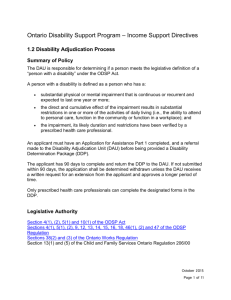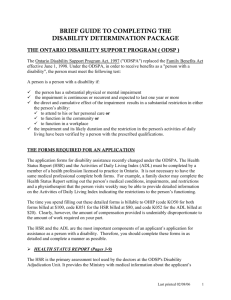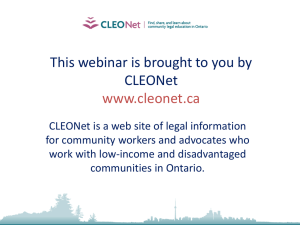ODSP: More Barriers than Opportunities
advertisement
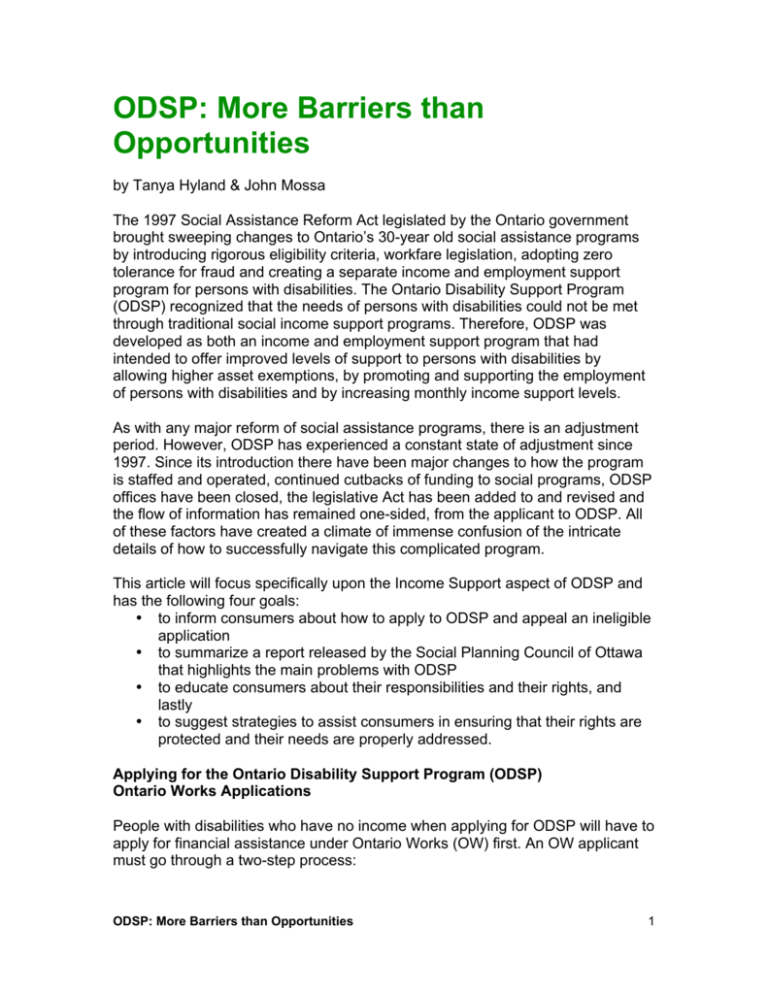
ODSP: More Barriers than Opportunities by Tanya Hyland & John Mossa The 1997 Social Assistance Reform Act legislated by the Ontario government brought sweeping changes to Ontario’s 30-year old social assistance programs by introducing rigorous eligibility criteria, workfare legislation, adopting zero tolerance for fraud and creating a separate income and employment support program for persons with disabilities. The Ontario Disability Support Program (ODSP) recognized that the needs of persons with disabilities could not be met through traditional social income support programs. Therefore, ODSP was developed as both an income and employment support program that had intended to offer improved levels of support to persons with disabilities by allowing higher asset exemptions, by promoting and supporting the employment of persons with disabilities and by increasing monthly income support levels. As with any major reform of social assistance programs, there is an adjustment period. However, ODSP has experienced a constant state of adjustment since 1997. Since its introduction there have been major changes to how the program is staffed and operated, continued cutbacks of funding to social programs, ODSP offices have been closed, the legislative Act has been added to and revised and the flow of information has remained one-sided, from the applicant to ODSP. All of these factors have created a climate of immense confusion of the intricate details of how to successfully navigate this complicated program. This article will focus specifically upon the Income Support aspect of ODSP and has the following four goals: • to inform consumers about how to apply to ODSP and appeal an ineligible application • to summarize a report released by the Social Planning Council of Ottawa that highlights the main problems with ODSP • to educate consumers about their responsibilities and their rights, and lastly • to suggest strategies to assist consumers in ensuring that their rights are protected and their needs are properly addressed. Applying for the Ontario Disability Support Program (ODSP) Ontario Works Applications People with disabilities who have no income when applying for ODSP will have to apply for financial assistance under Ontario Works (OW) first. An OW applicant must go through a two-step process: ODSP: More Barriers than Opportunities 1 1. A one-and-a-half-hour telephone Interview regarding assessment, their income and assets with OW worker; 2. An in-person verification interview at the local OW office. This includes a workshop about workfare requirements, which is mandatory for all applicants. ODSP Applications People with disabilities with income and assets over the eligible amounts allowed under OW must apply directly to a local ODSP office. An ODSP applicant also must go through a two-step process: 1. Must qualify financially for ODSP before 2. They can get the Disability Determination Package (4 forms) to show they qualify medically. Once an applicant qualifies financially, their local OW or ODSP office makes an electronic referral to the Disability Adjudication Unit (DAU) in Toronto and is given the Disability Determination Package. The Disability Determination Package The Disability Determination Package contains four forms. They are the following: 1. Health Status Report (HSR). This is a seven-page form that must be completed by a doctor, psychologist, or optometrist. HSR asks for a) the principal impairment; b) duration of disability; c) what medications and treatments the applicant is or was on and d) medical/specialists reports. 2. Activities of Daily Living (ADL). This is also a seven-page form completed by a doctor, psychologist, optometrist, audiologist, occupational therapist, physiotherapist nurse practitioner, or chiropractor. ADL asks about a person’s ability to do basic daily living activities. 3. Self-Report. The applicant has an opportunity to explain their disability and its impact "in their own words." 4. Consent to Release of Health Information These four forms must be filled out and sent to the DAU within 90 days or an applicant must go through the whole process over again. If you are getting OW benefits when you apply for the ODSP, and you miss the 90 day deadline, you may lose your OW benefits or you may have to participate in workfare. I The Decision-Making Process The DAU takes two to three months after receiving the 4 forms to decide if an applicant is “disabled.” DAU is staffed by people who are occupational therapists ODSP: More Barriers than Opportunities 2 or nurse practitioners qualified to fill out the ADL form. If an applicant is granted ODSP benefits, they are sent a written letter and an electronic confirmation is sent to the applicant’s local ODSP office. If a successful ODSP applicant were on OW, DAU would send an electronic confirmation to their local OW office. The OW office would then transfer the person’s file to the local ODSP Office, where an ODSP worker would set up an interview with applicant to go over their financial information. The Appeal Process and its Problems If the Disability Adjudication Unit (DAU) does not consider an ODSP applicant "disabled," they will inform the applicant by letter. The applicant has 10 days to write a letter to the DAU to request an INTERNAL REVIEW (IR). An IR means that a different person in the DAU office will review the application and decide whether or not to reverse the decision. If the DAU declines the applicant a second time, the DAU must inform theapplicant by letter in 10 days. An applicant will have 30 days to appeal the negative IR to the SOCIAL BENEFITS TRIBUNAL (SBT). During the appeal, the applicant can ask the SBT to order "interim assistance" benefits while they wait for their appeal. However, if the appeal is unsuccessful, the applicant will have to repay the benefits. The whole appeal process is problematic. The IR is considered a useless step because no new medical reports can be reviewed by the DAU. Only a small percentage of IR cases are overturned. II In addition, the IR acts as a disincentive. Applicants who have been initially turned down and then again at the internal review, might be hesitant or may not have theenergy to go through to the SBT. However, legal clinics report that 50 per cent of the appeals to the independent SBT are successful and the percentage is higher if the applicant has legal representation. III The SBT is a long process that has complex rules and deadlines for sending evidence to the SBT and the DAU. While a small percentage of denied applicants appeal to SBT, it still means thousands of appeals per year. SBT does not have the resources to handle the many appeals and therefore an appeal can take up to a year (in addition to the four-to-six month initial ODSP application process). During the waiting period, applicants will need to get Legal Aid lawyers to assist them with the collection of evidence and arguments to submit to the SBT hearing. In most cases, applicants will need to get more doctors’ reports to prove they are disabled. However, the DAU will refuse to look at any new medical reports until a few days before the SBT hearing, regardless of the fact that the new medical reports would reverse the decision. This means the DAU could be sitting on medical reports for up to a year before they look at them and this occurs at the financial and mental health expense of the applicant, as well as at the financial expense of the SBT. ODSP: More Barriers than Opportunities 3 Lastly, during the SBT process, the DAU is often late with making their submissions against the applicant, thus making it difficult for the applicant and their lawyer to respond to and prove their case. Summary of Ottawa ODSP report In response to the confusing nature of the ODSP program, the Social Planning Council of Ottawa (SPCO) held public forums in the Ottawa-Carleton area in November 2000 and released their report of these forums in October 2001. This was an opportunity for persons with disabilities to voice their concerns, frustrations and to suggest strategies for improving ODSP. What the SPCO detailed in their report were the often-cited examples of problems encountered by persons accessing ODSP. These included: 1. Getting on ODSP Qualifying for ODSP rests upon the ability of the applicant to prove two very important factors: that they meet the definition of disability developed by ODSP and that they are financially eligible. However, proving eligibility is most often a difficult and time-consuming task that involves numerous applications, forms and meetings with ODSP workers. Many applicants are forced onto the Ontario Works (OW) program, as the wait to receive income support from ODSP can be as long as four months, or longer if the application is denied. 2. Program Delivery Access to basic information about ODSP is difficult to obtain and bureaucratic barriers often prevent applicants from receiving information that could assist them with both the application process and answer questions that arise after they begin receiving ODSP. However, information provided by ODSP workers is often contradictory and usually not supplied in a written format. For individuals with visual or hearing impairments, information is generally not available in alternate formats. High staff turnover rates and constant changes to work procedures have resulted in confusion and zero accountability to those who access ODSP. 3. The Impact of Procedures and Policies Many ODSP workers are not familiar with, or comfortable assisting people with disabilities and sensitivity training should be a necessary component of the training of ODSP workers. Furthermore, ODSP offices are usually incapable of accommodating a variety of disabilities and many local offices have been closed. Of greatest impact is the atmosphere of fear created by ODSP, as those accessing the system are fearful of reporting or not ODSP: More Barriers than Opportunities 4 reporting information that may negatively affect their status on the program. 4. Employment Issues and Other Sources of Income The employment support program is governed by complex and inflexible rules that despite it being voluntary actually discourages people with disabilities from gaining employment. Many are fearful of losing their medical benefits and most often, the amount of money gained through employment does not match that available through the income support program. Support for access to education and training is not available through ODSP. 5. Medical Issues Approved medications are provided free of charge through the Ontario Drug Benefit plan, however the required medications must be listed in the "Comparative Drug Index." ODSP also operates a Mandatory Special Necessities program that covers the cost of diabetic and surgical supplies, incontinent supplies and medical transportation costs. Also available is a Special Diet Supplement for those with important dietary needs. However, these two programs are not promoted by ODSP workers, nor is program information readily available. Please refer to the ODSP Mandatory Special Necessities Information Sheet and ODSP Benefits Bulletin for more information. 6. Cost of Living and Securing Housing Most people who receive ODSP live below the poverty line and often run out of money before the end of the month. Although the cost of living has continued to climb, income support levels have remained unchanged. The benefit rates and rules are difficult to understand and access and vary from each individual. Furthermore, access to affordable housing, especially wheelchair accessible housing is difficult, as waiting lists are long in all major cities. Suggested Recommendations for Improvement offered by the SPCO Out of the forums held in Ottawa, recommendations for how to improve the ODSP system were developed. Below is a concise listing of these recommendations: 1. 2. 3. 4. Provide comprehensive, accurate, clear and written information Simplify and speed up the application process Increase the benefit levels to reflect the real cost of living Strengthen supports for employment for people with disabilities ODSP: More Barriers than Opportunities 5 5. Change policies which detract from ODSP clients’ ability to find and maintain housing 6. Improve service delivery by accommodating disabilities, ensuring accountability, and requiring respectful treatment of clients 7. Increase financial support for ODSP liaison workers in the municipal OW offices.IV Basic Facts about ODSP Income Support A single person on ODSP is entitled to a maximum of $930 per month with $516 allocated for Basic Needs and $414 as the maximum shelter allowance. However, to receive this income the applicant must meet the following requirements • • • • • they must prove that they meet the definition of disability, they must prove that they are financially eligible, they must demonstrate their monthly bills, rent and expenses. they must disclose any and all assets they may have, including providing bankstatements, credit card information they must disclose information about their personal and familial relationships. Despite this entitlement to a maximum of $930, the amount of income support actually received by applicants is directly related to their monthly expenses. For example, if an applicant resided in a subsidized apartment and paid rent in the amount of $225 per month, this is the maximum amount of shelter allowance they would receive. However, if an applicant’s rent were higher than the $414 allocated for shelter costs, the money needed to cover this cost would come out of the applicant’s Basic Needs allowance. The money left is then used to pay for groceries, monthly bills, transportation, clothing and toiletries. Most applicants are left with $20-30 at the end of the month and are therefore unable to save money for emergencies. Ministry Of Community & Social Services ODSP Mandatory Special Necessities Recipient Information Sheet As a recipient of Ontario Disability Income support, you may be eligible to receive additional assistance with the cost of Mandatory Special Necessities. These necessities include diabetic supplies, ostomy supplies, surgical supplies and dressings, incontinence supplies and travel medical appointments. DIABETIC SUPPLIES Supplies that qualify for assistance include: ODSP: More Barriers than Opportunities 6 • • • • • needles or syringes alcohol swabs platforms lancets blood glucose monitors (you may want to look into purchasing monitors that include the test strips covered by Ontario Drug Benefit Program) The above supplies are only eligible if they are not covered by another program. Your monthly ODSP drug card covers insulin and test strips. Before Requesting Funding From ODSP When your diabetes is controlled by insulin injections • You must contact the Canadian Diabetes Association at 1-800-226-8464 for the assistance with the cost of lancets and blood glucose monitors. Recipient who is blind or has a visual impairment • You should contact the Canadian National Institute for the Blind for possible coverage of the cost of a "talking" glucometer. Recipient who is 65 years or older • You must contact the Assistive Devices program at 1-800-268-6021 for possible funding of insulin needles and syringes. You Must Provide Verification note, prescription, or letter from your doctor which includes the following information: • • • • your medical condition number of injections/ needles required per day number of lancets tests needed per day an estimate from the vendor A new prescription is required from your doctor when there is a change in your needs. OSTOMY, SURGICAL & INCONTINENCE SUPPLIES Supplies that qualify for assistance include but are not limited to the following: • • diapers underpads ODSP: More Barriers than Opportunities 7 • • • • • • • • • • • • • • liners undergarments/briefs catheters drainage bags disinfectants leg straps lubricants catheter trays tubing adhesive/skin barriers enema kits catheter condoms ostomy supplies for colostomies and ileostomies (i.e. flanges, pouches, adhesive seals) other surgical supplies (i.e. gauze, dressings, adhesive tape, vinyl or latex gloves, skin preparations/antiseptics) You Must Provide Verification note, prescription, or letter from your doctor indicating: • medical condition • expected duration • necessary supplies • An itemized listing of your monthly costs including: • • receipts completion of Cost Verification forms available from your ODSP office Ostomy Patients You must provide verification that you have applied for the yearly grant of $800 from the Assistive Device Program at 1-800-268-6021. NOTE: If the condition is long term, an annual review will be required. MEDICAL TRAVEL & TRANSPORTATION ODSP will assist with the cost of medical transportation when the total costs are over $15.00 per month to attend: • • necessary medical appointments therapy or treatment by a professional under the Regulated Health Professionals Act (see below) ODSP: More Barriers than Opportunities 8 • drug and alcohol recovery groups (if recommended by the physician and available locally) Types of transportation: • • • • • Public Transit Taxi (prior approval required) Gas for personal vehicle on a per kilometer basis plus parking Accommodation and meals when necessary (e.g. overnight stays en-route for long trips, or during treatment that lasts for more than one day). Prior approval required. Other approved modes of transportation (service agency) You Must Provide Verification note, prescription, or letter from your doctor indicating: • • number of medical appointments per month expected duration of treatment You Must Complete • The Medical Transportation Log monthly Receipts are required for: • • • • overnight accommodation taxi parking meal costs All receipts must be attached to Medical Log PROFESSIONALS who are designated under the Regulated Health Professionals Act, 1991 are physician, optometrist, occupational therapist, physiotherapist, dentist, dental surgeon, dental technician, dental hygienist, denturist, optician, dietician, medical radiation technologist, massage therapist, midwife, nurse, pharmacist, speech language pathologist, audiologist, medical laboratory technologist, psychologist, respiratory therapist, chiropractor, chiropodist. ODSP: More Barriers than Opportunities 9 Other Ontario Disability Support Program Benefits BulletinV The ODSP Director must approve many of these benefits before you can receive them. You can contact your local ODSP office to request these benefits. If you have any problems, contact your local Legal Aid Clinic for help. ODSP RECIPIENT is a person with a disability who has met the financial and medical requirements to be on the program. Hereafter, known as the recipient. Definition of a SOCIAL BENEFIT UNIT is the recipient, their spouse or commonlaw partner and their dependents if they meet the financial and medical requirements of ODSP. While receiving ODSP, you are entitled to: • • • • • • • Drug coverage (for members of the social benefit unit) cost of drugs prescribed by an approved health professional listed under the Comparative Drug Index. Dental, vision, and hearing services (for members of the social benefit unit other than dependent adults) if those services have been approved. For persons resident in hospital or health facility, they are eligible for an amount approved by the Director for dental services, dentures, and prosthetic devices including eyeglasses, clothing, wheelchairs, and wheelchair accessories. Assistive devices:(for members of the social benefit unit) the amount the person is required to pay for an Assistive device under the Assistive Device Program administered by the Ministry of Health, up to the amount approved under that program. For more info on ADP call 1-800-268-6021 or in Toronto 416-327-8804. Cost of Assessment for Assistive Device: if an assessment is required to determine eligibility for an Assistive device and there is no other source of funding for the assessment, the amount determined by the Director Extended health benefits: if ODSP recipient is not eligible for income support in any month because of his or her income is more than the allowable income or where the person receives the minimum cheque amount of $2.50, the recipient remains eligible for the following: prescription drugs, dental, vision, and hearing services, diabetic supplies, surgical supplies, dressings and transportation for medical treatment and Assistive devices. Mobility devices and batteries and repairs: (for members of the social benefit unit) the cost of batteries and necessary repairs for mobility devices used by a member of the benefit unit if the cost is not covered by another source. Clients must obtain advance authorization from ODSP office before proceeding with any wheelchair repairs. Essential repairs under $500 may be covered without prior authorization if the ODSP office is closed and a back-up or loaned replacement is not available. Examples of "essential repairs" include the following: repairs to a flat tire, ODSP: More Barriers than Opportunities 10 • • • • • • • • replacement of a deficient battery, repairs due to mechanical breakdown of mobility device, breakdown of mobility device outside the client’s home. Winter Clothing Allowance: (for recipients with dependent children) pays $105 every 12 months for each child. Recipient must be eligible for income support in the month of October. Back to School Allowance: (for recipients with dependent children) pays out every 12 months for each child attending school ($ 69 for each child age 4-12, and $128 for each child age 13 and over). Recipient must be eligible for income support in the month of July. Special Diets: (for each member of the social benefit unit if the ODSP Director is satisfied that he or she meets the criteria for them) - up to a maximum of $250 per month for each participant who requires a special diet. A doctor must verify that the person requires a special diet and the doctor must set out the details of the special diet. Dietary requirements are reviewed every 12 months. Up front Child Care: (for recipients, a spouse or common-law partner included in the benefit unit, or a dependent adult who is not attending school full time). Available when a person begins employment or an employment assistance activity. The ODSP Director must be satisfied that the person is required to pay in advance for child care and that the child care is necessary to permit the person to begin the new employment activity. The amount available in any 12 month period is: o The actual amount paid to a person licensed under the Day Nurseries Act o $390 per month if the child is under age 6; o $390 per month if the child is 6 years or older and, in the opinion of the Director, because of special circumstances the child requires increased childcare costs; o $346 per month if the child is age 6-13 and 3) doesnot apply. Guide Dog: maximum of $64 for care of guide dog if a member of the benefit requires one. Travel and Transportation: If a person is resident in a charitable institution under the Charitable Institutions Act, an amount up to $30 per month to cover costs oftraveling in the community. Necessary Home Repairs: If no other sources of funding are available, an ODSP recipient may receive payment from home repairs to a principal residence. The ODSP Director must be satisfied the repairs are necessary in order for the home to continue to be used as a principal residence (certain repairs excluded). The payment cannot be more than the portion of the total cost of repairs that matches the person’s proportionate interest in the property. Second Residence: If a person with a disability needs to temporarily change his or her normal place of residence in order to take part in an employment-training program, the person may receive an equal amount to the cost of maintaining the normal place of residence during the training ODSP: More Barriers than Opportunities 11 • up to $455. Costs that are covered by another source will not be covered by ODSP. Assistance from Family and Friends - are allowed to assist regularly with the needs to a maximum of $4000 per year. There is no limit for disability-related expenses. Ownership of a second Property - exempt as an asset if approved for the health and well being of recipient. Community Start-Up Benefits Community Start-Up Benefits (CUSB) are mandatory benefits. With this benefit, ODSP will pay the recipient money to help "start-up" a life in new housing under certain conditions. You are entitled to claim expenses for clothing, household furnishings, moving and transportation, first and last month’s rent, fuel and hydro deposits or any other cost approved by ODSP. Eligibility for CSUB includes, but is not limited to the following: • • • • • Must be coming out of an institution (e.g. hospital, hostel, nursing home, jail) or be leaving, or have recently left, a situation of harm to your health or welfare (e.g. fire, flood, domestic violence) May also receive benefit if moving to more affordable housing, or due to overcrowding or eviction. ODSP must be able to verify the expenses that you are claiming the benefit for Expenses must be necessary for establishing a permanent residence in the community The start-up event should occur within one month from the date of application for CSUB, or the establishment of a new residence. Employment Start-Up Benefits Employment Start-Up Benefits (ESUB) are available to help with costs related to the changes in employment or starting an employment assistance activity. These benefits are available once a 12-month period to an ODSP recipient, a spouse included in the benefit unit, or a dependent adult who is not attending school fulltime. ESUB allow you to claim for expenses approved by the Director and reasonably necessary for you to begin a new employment activity. Expenses covered may include things such as appropriate work wear, tools and equipment, grooming costs, licensing fees, and associated costs. This benefit may be paid out in a lump sum or over a 12-month period up to a maximum of $253. Strategies Below are some suggestions for how to successfully navigate the ODSP system. ODSP: More Barriers than Opportunities 12 • • • • • • • I. II. III. Use your ‘worse’ days - When filling out medical forms with your doctor/specialist, submitting specialist/medical reports and/or giving your self-impact statement about your disability, always use your worse days as the norm for your daily living experience. The Disability Adjudication Unit will look for any bit of information that demonstrates that an applicant has some good days, or is capable of doing some tasks, and therefore does not meet their eligibility requirements for being considered ‘disabled.’ Do Follow Ups - When you apply for Ontario Works (OW) or ODSP, you need to call, one week after submitting your application, to ensure that the OW or ODSP office has made an electronic referral of your application to the central Disability Adjudication Unit. Appeal, Appeal, Appeal! - Don’t stop applying for ODSP benefits if you are initially rejected. Submit a letter within 10 days requesting an Internal Review. Most likely, you will be turned down at the Internal Review, however appeal that decision to the Social Benefits Tribunal and get legal assistance. Get Legal Assistance with your Appeals - You can access legal advice for your Internal Review and legal representation for your Social Benefits Tribunal Hearing from your community legal clinic. To locate a community legal clinic contact Ontario Legal Aid at 1-800-668-8258 or in Toronto at 416-979-1446, or the Legal Aid Ontario Web at www.legalaid.on.ca. You can also use the white pages of the telephone book, under "Legal Aid," "Legal Clinic" or look under "Lawyers" in the yellow pages. Keep Records - Maintain an ODSP folder and photocopy of all information you submit to ODSP. Request photocopies of any documents you sign at the ODSP office. Maintain a record of all contact with ODSP, including dates, times and the name of the ODSP workers. Educate yourself about ODSP. Attend community events and meetings that discuss ODSP. Request a copy of the ODSP Policy Directives and Legislation. The Directives are also available at: http://www.gov.on.ca/CSS/page/brochure/odspis/odspis.html. Speak with your MPP - They are your representation and voice at the legislature. Tell your MPP about your personal situation and pressure for an increase to the amount of income support that reflects the rise in the cost of living. “ Social Assistance: Disability Benefits in Ontario”, by HIV & AIDS Legal Clinic, edited by Community Legal Education Ontario, November 2000. p. 8. “Barriers to Access to ODSP: Why are thousands of people with disabilities denied income support?” Nancy Vander Plaats, Ontario Social Safety Network. February 2002. Ibid. ODSP: More Barriers than Opportunities 13 IV. V. The Experience of People with Disabilities in Ottawa and the Ontario Disability Support Program. (ODSP). Report prepared by the Social Planning Council of Ottawa. October 2001. “Ontario Disability Support Program: What Are You Really Entitled To?”, Parkdale Community Legal Services Inc. ODSP: More Barriers than Opportunities 14

